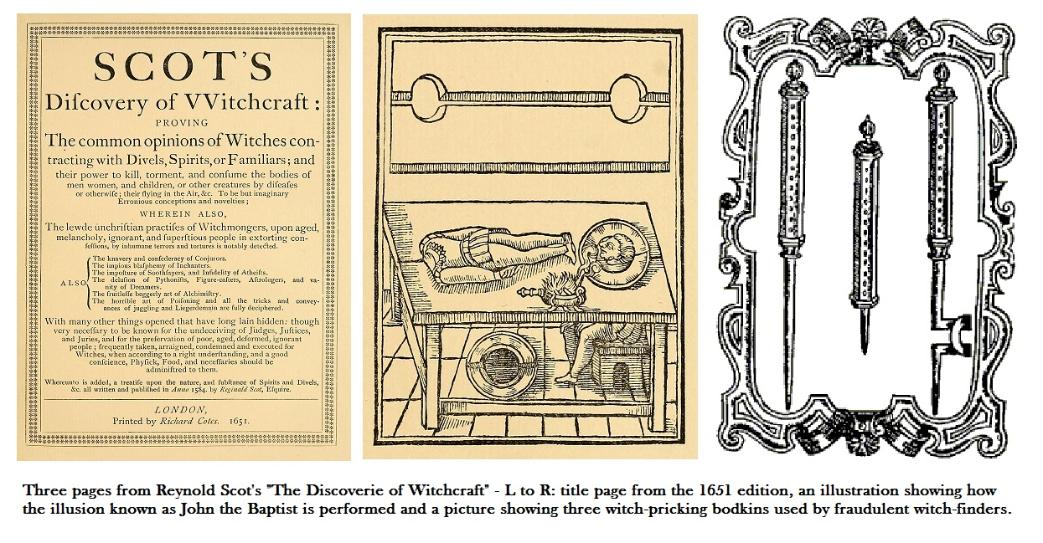THE FAMILY OF LOVE - REYNOLD SCOT & THE DISCOVERY OF WITCHCRAFT
Much has been written about the witch-mania that swept through Europe during the 15th, 16th and 17th Centuries but not everyone was convinced that Satan was hiding in every barn. One such sceptic was a Tudor country gentleman named Reynold (Reginald) Scot who was so distressed by the murderous craze he wrote "The Discoverie of Witchcraft" in order to counter the claims of the sadistic witch-hunters.
Scot was born c.1538 in Kent. His family were moderately wealthy and Reynold lived most of his life as a country squire. He was the Member of Parliament for New Romney, a magistrate and a captain in the militia. He farmed his estates quietly and would have died in obscurity had he not joined a small Protestant sect called the Family of Love.
Unusually for the time, this sect did not try and overthrow the established Church of England and, as its principle message was one of peace and respect for authority, it was tolerated by Queen Elizabeth I's government. In fact the sect’s only controversial doctrine was the belief that Satan exerted his power in the mind alone, through temptation, therefore witches did not exist.
In 1584, in accordance with these beliefs, Scot published “The Discoverie of Witchcraft” and in the book’s lengthy subtitle he promises to expose the: “lewde dealing of Witches and Witch-mongers, the knaverie of conjurors, the impietie of inchantors, the infidelity of atheists and the pestilent practices of Pythonists…” Pythonists here refers to soothsayers in the tradition of the Pythia, the ancient prophetess of Delphi, and not the 1970s comedians!
In his book, Scot not only argues that the persecution of those accused of witchcraft was un-Christian, he demonstrates exactly how fraudsters and charlatans trick the gullible into believing they possess occult powers. Besides the detailed descriptions of many familiar conjuring tricks, such as making coins disappear and sawing people in half, there are plenty of illustrations showing exactly how these sleights-of-hand are performed.
"The Discoverie of Witchcraft" has often been called the first manual of stage magic but Scot’s aim was far more serious. He wanted to prevent the poor, the elderly, and the simple minded, who were those most frequently accused of being witches, from being tortured and hanged (English witches usually went to the gallows rather than the stake and Scottish witches were often strangled before their bodies were burned).
As a Protestant, Scot had no hesitation in blaming the Roman Catholic Church for perpetuating belief in superstition and he also attacks the writers of witch-finding manuals such as Jacobus Sprenger, whose “Malleus Maleficarum” ("The Hammer of Witches" published in Nuremberg in 1494) is largely credited with popularising Europe’s prurient obsession with the occult. That said, Scot is not entirely free of superstition himself and he expresses a firm belief in the power of unicorn horn to cure illness.
Scot died in 1599 but the controversy his book provoked continued for many years after his death. There were plenty of supposedly learned clerics in the Church of England who defended the persecution of witches and England’s new Scottish King James I/VI (r.1603-1625), who had penned several works in support of witch-finding, ordered all copies of Scot’s book to be burned.
Sadly the witch-mania was so entrenched “The Discoverie of Witches” did little to save the hundreds of people executed for witchcraft between 1542, when Henry VIII passed the first of the Witchcraft Acts and 1727 when an elderly Scottish woman named Janet Horne had the misfortune of being the last person in Britain to be burned to death for being a witch.
Nevertheless, the book did have some influence on the 17th and 18th Century scholars who created the Age of Reason and in 1735 the British Government passed the Witchcraft of Act which made it a criminal offence for any person to claim that any human being had magical powers or was guilty of practising witchcraft.
Reynold Scot is one of the inspirations for Thomas Devilstone, my fictitious Tudor alchemist-sorcerer who begins to doubt the reality of magic. For Halloween, the hero of The Devilstone Chronicles stars in a new short story, Thomas & the Necromancer, which you can read in full and for free at: http://www.thedevilstonechronicles.com/Thomas-and-the-Necromancer.php
